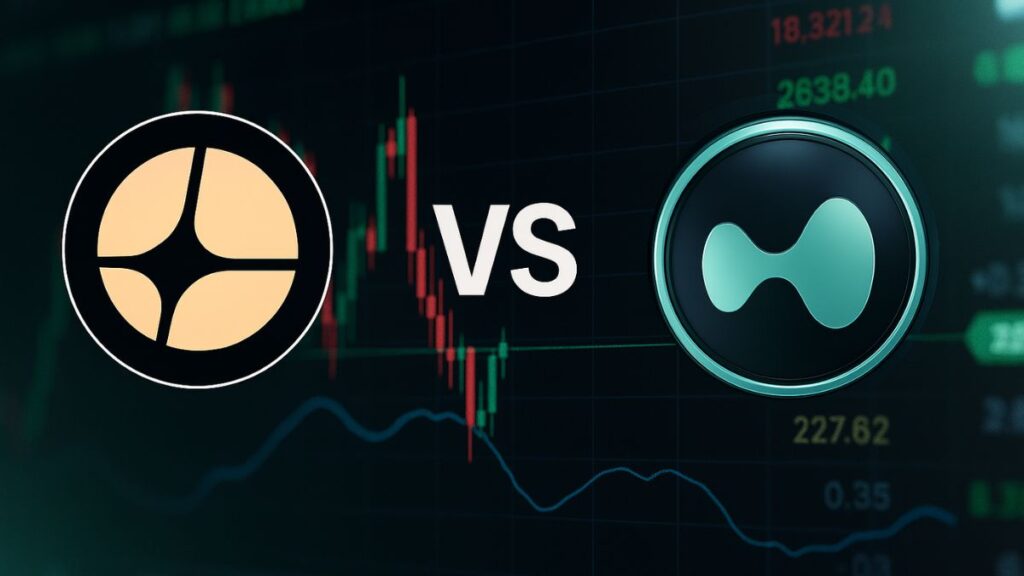Rivalries often define the pace of decentralized finance, drawing as much attention as the technologies themselves. Hyperliquid and Aster stand as two distinct visions competing for influence, each shaping unique narratives. Their confrontation reflects not only market ambition but also the evolving imagination of traders exploring digital frontiers.
Hyperliquid vs. Aster: Competing Visions

Market Context and Emerging Competition
The decentralized finance sector has entered a new phase where perpetual futures dominate trading activity, and two platforms are at the center of this evolution. Hyperliquid operates as a performance-first decentralized exchange built on its own Layer 1 blockchain, engineered for sub-second execution and deep liquidity pools. On the other hand, Aster positions itself as a multi-chain venue with tokenized stock offerings, aggressive leverage, and liquidity aggregation across ecosystems. Both platforms aim to redefine how traders access perpetual futures. Still, their strategies diverge significantly, creating a competitive landscape that reflects broader DeFi trends.
Hyperliquid’s Execution-Driven Model
Hyperliquid’s architecture is designed to replicate a centralized exchange performance while maintaining full decentralization. Its custom consensus mechanism enables block times under one second, supporting over 100,000 orders per second. This infrastructure appeals to professional traders and market makers who demand precision, low latency, and transparent on-chain order books. With leverage up to 40x and a native stablecoin (USDH) integrated into its ecosystem, Hyperliquid emphasizes reliability, execution quality, and community-driven governance through validator participation.
Aster’s Incentive-Led Expansion
Aster differentiates itself by offering extreme leverage and integrating tokenized stocks alongside crypto perpetuals. Its multi-chain presence across Ethereum, BNB Chain, Solana, and Arbitrum allows broad accessibility, while features like fee discounts via the ASTER token and gamified reward systems attract retail traders. Aster’s strategy relies heavily on incentives and cross-chain liquidity routing, making it appealing for users seeking aggressive trading opportunities and diverse asset exposure.
Strategic Implications for Traders
The rivalry between Hyperliquid and Aster highlights two distinct approaches: execution depth versus feature breadth. Hyperliquid appeals to traders prioritizing speed, stability, and professional-grade infrastructure, while Aster caters to those drawn to high leverage, multi-chain access, and incentive-driven ecosystems.
For market participants, the choice depends on whether they value consistent execution and governance alignment or prefer expansive features and aggressive trading opportunities. This competition underscores the broader maturation of decentralized perpetual futures markets.
Governance, Tokenomics, and Ecosystem Development

Governance Structures and Community Role
Hyperliquid and Aster diverge significantly in how they approach governance. Hyperliquid emphasizes validator-driven decision-making, where network participants validate transactions and influence protocol upgrades. This model ensures that governance remains closely tied to infrastructure stability. Aster, conversely, integrates governance through its ASTER token, granting holders voting rights on fee structures, incentive programs, and new asset listings. The contrast highlights two philosophies: infrastructure-centric governance versus token-holder empowerment.
Token Utility and Economic Incentives
The economic design of each platform reflects its strategic priorities. Hyperliquid’s native stablecoin, USDH, underpins liquidity and collateral management, while its HYPE token incentivizes validators and secures the network. Aster’s ASTER token plays a broader role, offering fee discounts, staking rewards, and access to exclusive trading tiers. By embedding token utility into daily trading activity, Aster fosters strong user engagement, while Hyperliquid prioritizes systemic stability and validator alignment.
Ecosystem Partnerships and Integrations
Partnership strategies also set the platforms apart. Hyperliquid focuses on building institutional-grade relationships with liquidity providers and market makers, ensuring deep order books and reliable execution. Aster, on the other hand, actively integrates with multi-chain DeFi protocols, expanding its reach across Ethereum, BNB Chain, Solana, and Arbitrum. These integrations allow Aster to tap into diverse liquidity sources, while Hyperliquid concentrates on refining its proprietary Layer 1 ecosystem.
Long-Term Sustainability and Growth
Sustainability depends on how each platform balances incentives with resilience. Hyperliquid’s validator-centric model may appeal to long-term stakeholders seeking predictable governance and robust infrastructure. Aster’s incentive-heavy approach could drive rapid adoption but risks over-reliance on rewards to maintain user activity. Ultimately, the sustainability of each ecosystem will hinge on whether governance and tokenomics can adapt to evolving market conditions without compromising security or user trust.
Security, Innovation, and User Experience

Security Frameworks and Risk Management
Security remains a defining factor in the competition between Hyperliquid and Aster. Hyperliquid employs a custom-built Layer 1 chain with rigorous validator oversight, ensuring that transaction integrity and order book transparency are preserved. Its architecture minimizes reliance on external bridges, reducing exposure to cross-chain vulnerabilities. Aster, by contrast, leverages multi-chain connectivity, which expands accessibility but introduces additional attack surfaces. To mitigate risks, Aster integrates advanced auditing protocols and insurance mechanisms, aiming to reassure users despite its broader exposure.
Technological Innovation and Performance Enhancements
Innovation drives both platforms, though in different directions. Hyperliquid focuses on refining throughput and latency, continuously upgrading its consensus mechanism to support institutional-grade trading. Its roadmap emphasizes scalability without compromising decentralization. Aster, meanwhile, prioritizes feature innovation, experimenting with tokenized equities, synthetic assets, and gamified trading experiences. These innovations appeal to retail audiences seeking variety, while Hyperliquid’s performance-first approach resonates with professional traders demanding reliability.
User Interface and Accessibility
User experience is another area where the platforms diverge. Hyperliquid’s interface mirrors centralized exchanges, offering advanced charting tools, order types, and analytics tailored for high-frequency traders. Its design prioritizes efficiency and precision. Aster, conversely, adopts a more gamified and visually engaging interface, lowering entry barriers for newcomers. By simplifying onboarding and integrating reward-driven dashboards, Aster positions itself as a platform accessible to a wider demographic of traders.
Broader Implications for Market Evolution
The contrasting approaches to security, innovation, and user experience illustrate how decentralized perpetual futures are evolving. Hyperliquid’s emphasis on infrastructure resilience and professional-grade tools suggests a path toward institutional adoption. Aster’s focus on accessibility and experimental features highlights the sector’s potential to attract mainstream retail participation. Together, these strategies demonstrate that the future of decentralized trading will likely be shaped by both institutional rigor and consumer-driven innovation.
Conclusion
Hyperliquid and Aster illustrate two divergent paths shaping decentralized perpetual futures. One emphasizes infrastructure resilience, validator governance, and execution quality, while the other pursues multi-chain reach, incentives, and accessibility. Their rivalry underscores how institutional rigor and retail-driven innovation together define the evolving landscape of digital trading platforms.









